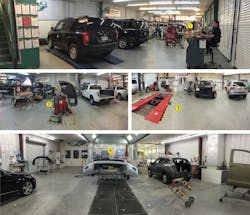Frank Rinaudo started working on cars when he was 15 years old, and by 17, he was working in a friend’s father’s shop. He also started painting cars in the garage behind his house. Then in 1990, Rinaudo purchased his own body shop, Frank’s Accurate Body Shop in Slidell, La. Almost three years ago, the shop began practicing lean theory. Rinaudo toured Marshall Auto Body where Aaron Marshall explained lean production.
“A lightbulb went off in me,” Rinaudo says. “I hired him and he came and helped me implement this system into my shop. He’s been kind of a coach to me.”
1. “We’ve been studying and implementing lean for probably three years now,” Rinaudo says. “Our system is derived from the Toyota production system.” Each vehicle goes through repair planning, complete disassembly and thorough damage analysis. “From there, it’s a single-piece workflow,” he says. “Once the car is injected into the flow line, it’s designed to stay there until it’s completed.”
2. “The single piece workflow is designed to expose problems so you can learn from them and improve them,” Rinaudo says. Though the building design doesn’t allow Frank’s to have the process run in a straight line, each part of the process has a specific location. It flows from repair planning, through parts into the heavy welding and structural area.
3. In the next part of the process, vehicles go onto the alignment rack and then into reassembly and detail. Rinaudo is part of a 20 Group with other independant repair shops. They meet twice a year and tour shops around the country that are into lean theory.
4. “We’re not the traditional shop where [vehicles are] pulled in and out a lot and one technician owns the job,” he says. Rinaudo does not pay his technicians based on commision. He believes that paying them hourly emphasises the teamwork needed to successfully implement the shop’s lean practices. The hardest part, Rinaudo says, is changing the way he and all the techs think about how hourly pay would make the repair process smoother. Everybody is much happier to help each other out, he says. Each phase of the process has the related tools, parts, supplies and equipment so that phase of the process is only done in one area. After detail, the next part of the building, which is connected by an overhang, has a stall for light body work before vehicles head into paint and back up to reassembly. “If we’ve done our job well, it goes all the way through production without stopping,” he says.
